This week brought news that both of my submissions for Regeneration: Contemporary Quilt Textiles 2012 have been selected. This is a curated, themed exhibition and applicants were required to submit concept designs including sketches and other supporting materials. According to the curator’s statement “Regeneration’ will feature the use of “individual display boxes for each work showing the artists’ sources of inspiration,photos, sketches, samples of their fabrics and techniques – any material which the artist believes will help convey to the audience the story behind the finished work.â€
I have to admit that pulling together a submission for Regeneration ran counter to my usual studio practice. My collection of journals with predominantly pristine pages is testament to my inability to maintain a visual diary in any meaningful fashion. I rarely plan a design in detail in advance, preferring to work more improvisationally at the design wall. And, Twelve by Twelve works aside, I avoid making any commitment to size ahead of time as my quilts tend to have a mind of their own.
I’m not sure how much I can share with you about my Regeneration pieces at this stage. However, I have recently been through a similar exercise of designing and delivering a work and it seems timely to consolidate the steps in that process all in one post.
I was honoured when my talented friend Lisa Walton invited me participate in the display of student work that she is presenting at the International Quilt Festival in Houston in November as part of the Jewel Pearce Patterson Scholarship for Quilting Teachers. We had a fabulous Textured Treasures play day together in December and I spent the summer mulling over ideas that I might incorporate into a 50x50in piece. Fast forward to the beginning of March and it was time to submit my Sydney Quilt Show entry form, time to FOCUS. So here is the concept design that accompanied my entry form – monoprinted pohutukawa blooms with stamped kiwi words and a textured sea.
Along the way, I tried out some monoprinting in the BrownSageBlue Twelve by Twelve challenge although I ultimately selected a pieced work for my official contribution.
I also tried out some practice monoprints on paper:
Time to graduate to fabric.
Then I photoshopped auditioned some leaves and words (but of course, alphabet stamps don’t come in this scale – rats):
One disadvantage of monoprinting on a wholecloth is that one mis-step can spoil the entire piece. As I wasn’t entirely happy with some of the flowers in my first effort, I monoprinted another set of flowers and and bubble-wrap stamped some water:
It was only at this point that I realised that painting in the white background was not going to produce the desired effect. Sigh. I should have tried this sample earlier.
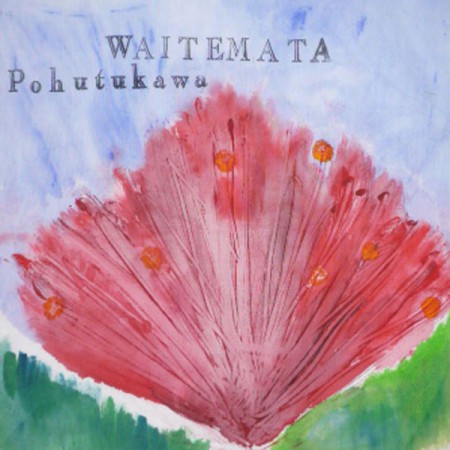
Between the flu and a family bereavement, I lost a month in April. May found me monoprinting the flowers a third time. This time onto some turquoise fabric dyed by Lisa. That worked BUT then the bubble-wrap printed water was all wrong. Off to dye some shibori water instead.
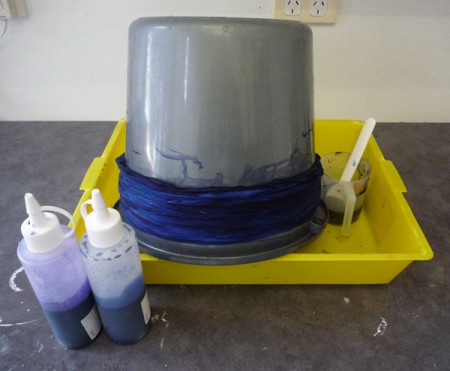
Stamping the words was rather nerve-wracking. I used the peelable plastic letters and a plastic block that you can buy at scrapbooking shops. Sometimes the letters did not stick to the block very well and I had visions of stray letters all over the quilt. Then there was the Goldilocks inking challenge – not too much, not too little, just right?
Once assembled, I machine quilted the shibori sea along with hundreds of individual red lines in the flowers. If I thought that took hours, then it was nothing compared to hand stitching the background and beading the nectar spots:

Finally the quilt was finished in time for the Sydney Quilt Show and, miraculously, it is actually 50x50in. If you are going to the International Quilt Festival, check it out in the special exhibits:
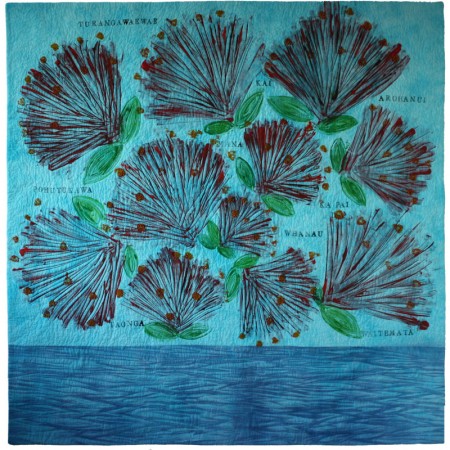
Pohutukawa Taonga: Gracing the New Zealand coast, pohutukawa flowers and their spectacular blossom are a national taonga (treasure). The stamped Maori words, reminiscent of wool bale stencils, denote other treasures of my kiwi upbringing: love, family, food, respect, belonging and well-being. (Monoprints, shibori, stamping, beading and hand stitching.)

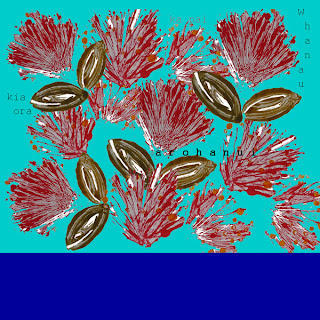




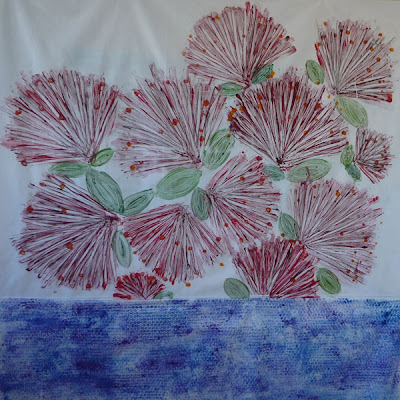

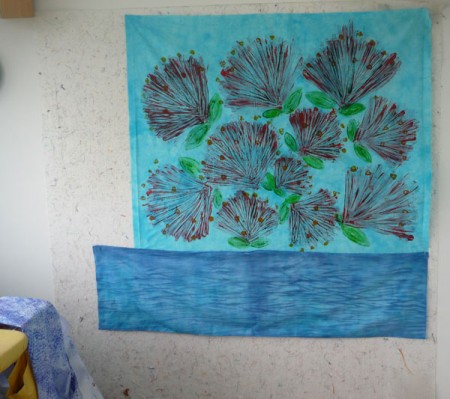
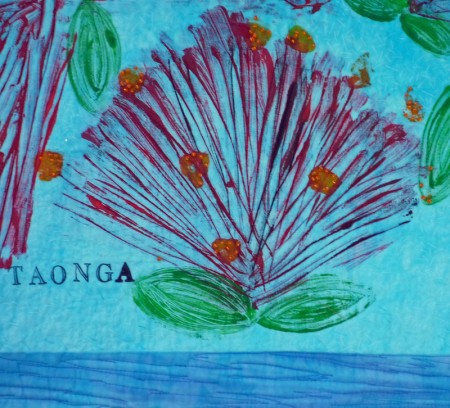

Cait says
Thank you for sharing these steps Brenda! Like you, I find it difficult recording a process as my pieces evolve as I go along, so I could relate very easily to your steps here! I love the Waitemata one too … all brilliant. Cheers, Cait Gordon
Pamela Priday says
Congrats Brenda on being accepted for Regeneration.
Helen Ducker says
Thanks for sharing this Brenda. I can relate to every step of the way, the failures, the way life takes time away and adds frustration, things falling off and taking far more time than anticipated.
I too was daunted by the Regeneration requirement for concept designs as my pieces usually change drastically along the way, and often bear no resemblance to my initial thoughts and sketches. So I couldn’t imagine how they could possibly make a sensbile decision from my initial designs.
Neroli says
Hi Brenda, this doesn’t look like most of the work i’ve seen by you at all!! Love the concept and the way you’re trying something totally different. The new water is so much nicer and the overall design idea has enough of old botanical pics mixed with modern style to make it really interesting. The quilting really adds to it too. Thanks for sharing the whole methodology!!
Brenda says
Thanks for stopping by Neroli.
Freeform piecing remains my preferred modus operandi but it was fun to play with paint and beads!
Judy says
Brenda,
It’s great that you shared your process with us all, I wouldn’t have a clue how to approach a curated show (most likely not think of doing so), I too have the journal “pristine” as you say and my quilts are a hit and miss affair, the way i like it. Thanks again for sharing the experience , I think the quilt you took as an example came out beautifully. Also congratulations on having a quilt in Lisa’s student show in Houston.
Pam Johnson says
Brenda,
Thanks for sharing the process; it so reinforces the old adage about 5% inspiration and 95% perspiration. This would be a great example to show our middle/ high school students who tend to give up if they can’t immediately achieve what they set out to do. Sometimes it’s OK to let the piece go in whatever direction it seems to have found, but this shows what wonderful results can come from persistence and experimentation to get just the right effect. It certainly inspires me to do the same.
Claire says
I enjoyed the sharing of your process, and I am looking forward to seeing the piece up close and personal at the Houston show.
Sue Reno says
Really enjoyed reading about your process, and congratulations on the acceptances! It’s beautiful work.